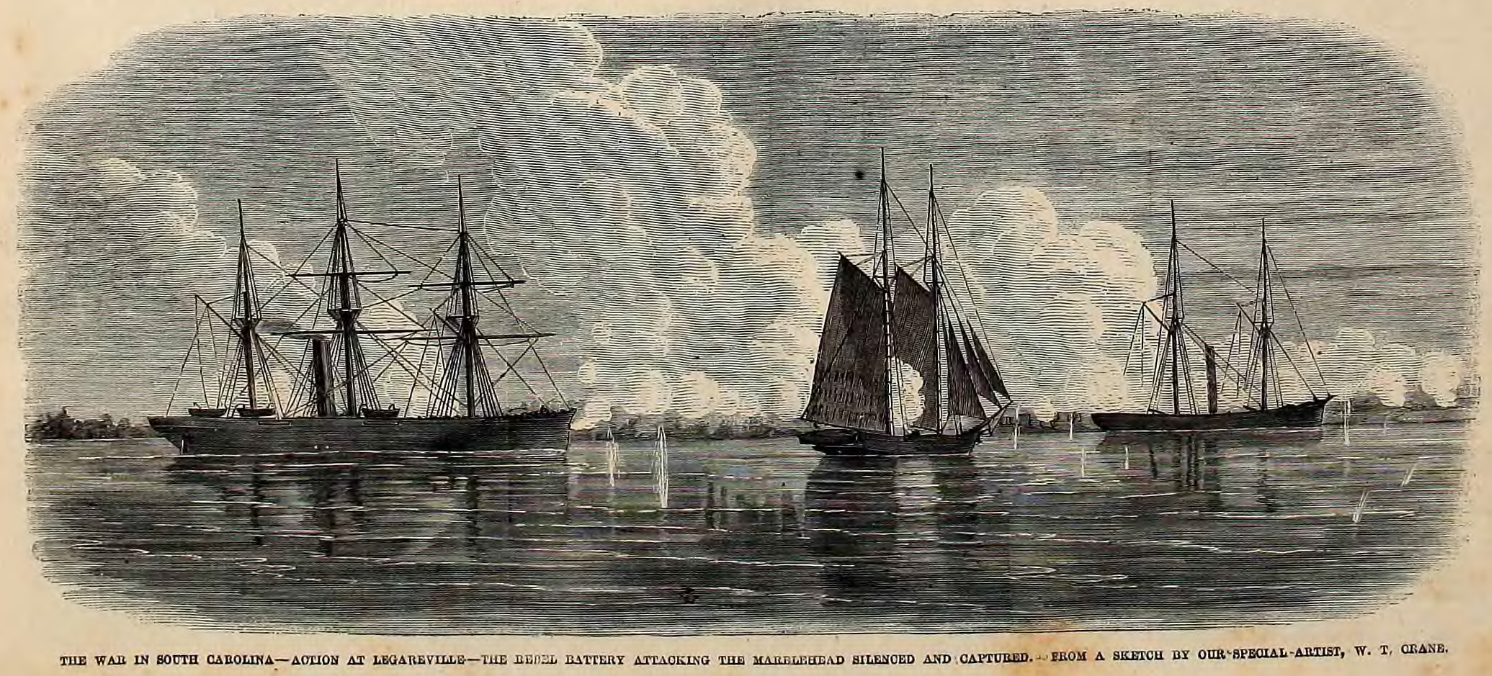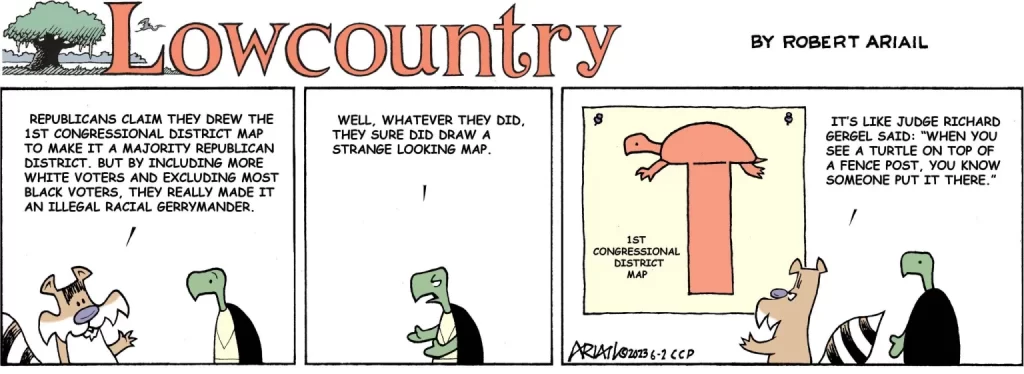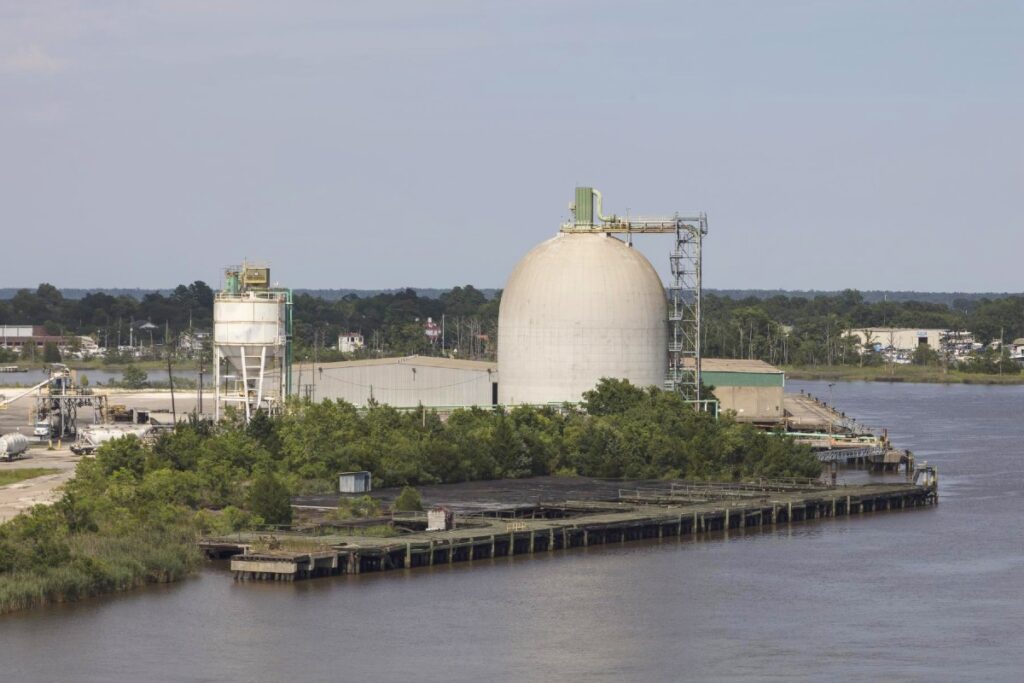STATEHOUSE REPORT | ISSUE 22.22 | June 2, 2023
BIG STORY: A Civil War hero’s story that may be new for you
LOWCOUNTRY, Ariail: Turtle on top of a fence post
COMMENTARY, Brack: Be careful because Covid still lurks
FEEDBACK: Send us your thoughts
MYSTERY PHOTO: Industrial scene
EDITOR’S NOTE: This week’s Report is limited. You’ll figure out why when you read the commentary.
A Civil War hero’s story that may be new for you

EDITOR’S NOTE: This is one of the most interesting history stories we’ve read of late. You’ll learn how a South Carolina man became the first Black serviceman to be awarded the congressional Medal of Honor – in 1864.
By Herb Frazier | Civil War battles freed Robert Blake from slavery at a Charleston County rice plantation on the South Santee River. Then a rebel attack thrust him into a near-death moment of bravery near Johns Island that led to a historic Congressional Medal of Honor being pinned on his chest.
Blake was among 400 enslaved people the Union Navy rescued in late June 1862 during a raid on the Blake Plantation near McClellanville. Blake and about 20 enslaved men from the plantation later entered the Union Navy. Blake’s action during a Confederate attack at 6 a.m. on Christmas Day 1863 on the Union gunboat Marblehead earned him the nation’s highest military decoration.
As the vessel patrolled the Stono River near Legareville, a summer retreat for area planters on Johns Island, an exploding Confederate shell killed the powder boy and knocked Blake to the deck. A bruised Blake jumped up, stripped to the waist and began running powder boxes to the gun loaders.
The Marblehead’s captain asked Blake, the boat’s cook who had no combat role, what was he doing. Blake answered with gospel song lyrics inspired by Revelation 6:15-17: “Went down to the rocks to hide my face, but the rocks said there is no hiding place here. So here I am, sir.” Blake was later promoted to seaman.
Blake received the medal in 1864. He is considered to be the first Black Civil War combatant to “actually” receive the medal of honor in person. Civil War soldier and medal recipient William Harvey Carney, best known for holding the American flag high during the Union’s July 1863 assault on Battery Wagner at Morris Island near Charleston, received the medal in 1900, 36 years after Blake. But Carney is credited as the first Black medal recipient because his heroism occurred before Blake’s.
As of March 2023, 3,525 service men and women have received the medal, according to the Congressional Medal of Honor Society. Blake, who is among 94 Black medal recipients, is listed in the Medal of Honor Museum on the USS Yorktown at the Patriots Point Naval and Maritime Museum in Mount Pleasant. But unlike Carney’s heroism, Blake’s story is not prominently displayed.
Area man may be related to hero

Darius Brown, a research assistant in the Center for Family History at the International African American Museum, said he believes he is related to Blake.
“[It is] awesome to know that another potential relative of mine was a war hero,” said Brown, who grew up in Beaufort and has family ties to the South Santee. “Like my other numerous Civil War relatives, their stories should be heard and honored.”
Joseph McGill Jr., a Black Civil War reenactor and history and cultural coordinator consultant at Magnolia Plantation and Garden, laments that Blake may remain a lesser-known Civil War hero since the popularity of Civil War reenacting has declined. Reenactments gave Black Civil War buffs the stage to interpret the lives of Black sailors and soldiers like Blake and Carney. But reenactments are no longer popular, he said.
Dylann Roof, a Confederate-flag-waving avowed racist, tarnished the shine of Civil War reenactment in June 2015 when he killed nine members of Emanuel African Methodist Episcopal Church in Charleston, McGill said.
A Winyah Bay exodus
Arthur Middleton Blake purchased a colonial-era rice plantation in 1843 that by the time of the war covered more than 9,000 acres. During the fighting, Confederates used the plantation as a base for blockade-running boats. When Union gunboats approached, the Confederates opened fire. The Union returned fire, and seamen and marines went ashore. After a brief skirmish, some 400 enslaved people, including Blake, boarded the Union boats. Today, the Blake Plantation is the Santee Coastal Reserve Wildlife Management Area.
The Union called the formerly enslaved people “contraband” after they became under Union control. “Contraband of war is property taken during a war,” said East Cooper historian Suzannah Smith Miles. “Unfortunately, in this instance, it meant human beings that were the property of their owners.”
The formerly enslaved people were taken to North Island in Winyah Bay near Georgetown where Robert Blake and about 20 other men entered the Union Navy, said Miles, a historian at The Village Museum in McClellanville. Records show that Blake entered the U.S. Navy on June 30, 1862, she said. Other men also entered the military at that time. Some of them returned to the Blake Plantation after the war, she added.
Enslaved people on North Island experienced destitute conditions with limited clothing and food. An informant in July 1862 told the Union that 500 rebels near Georgetown were preparing to attack North Island “with the intentions of destroying the contrabands … which number 700 men, women and children,” according to Barbara Brooks Tomblin, author of Bluejackets and Contrabands: African Americans and the Union Navy.
By 1863 and 1864, people on North Island, including people from the South Santee, were moved to Port Royal in Beaufort County and other coastal camps under Union control. The Union seized Port Royal in November 1861 during a heavy naval bombardment enslaved people called “the big gun shoot.”
Growing up in Beaufort
In 2017, Brown said he began researching his family and compiling oral histories “to go back as far as I could,” he said. “I always knew that I had ancestors who were enslaved by the Blake family,” said Brown, 25. “My great-grandmother, Margaret Jiles Brown, talked about it when I was younger. She said her family came from the Santee near Georgetown.
“I haven’t made a [family] connection with Robert Blake,” Brown admitted. “He is hard to find in the records. It is possible that I am related [to him as] a distant cousin because I have two sides of my family that came from that plantation,” he said. Brown said some of the South Santee families who were brought to Beaufort settled in the Gray’s Hill community where he grew up.
Brown has discovered kinship ties with more than 20 formerly enslaved men from the South Santee who were taken to Beaufort. A few of them joined the U.S. Army and participated in a June 1863 raid on the Combahee River that freed about 700 enslaved people, he said.
Discovering ancestors who fought to end slavery “gives me a sense of pride,” Brown said. “I have close to 30 relatives who fought in the Civil War, and that tells me they weren’t just concerned about their freedom but the freedom of others.”
Herb Frazier is special projects editor with the Charleston City Paper, where this story first appeared. Have a comment? Send to: feedback@charlestoncitypaper.com
Turtle on top of a fence post

Cartoonist Robert Arial, always creative and entertaining, offers this take on South Carolina’s love affair with racial gerrymandering. Love the cartoon? Hate it? What do you think: feedback@statehousereport.com.
Be careful because Covid still lurks

By Andy Brack, editor and publisher | For the last 40 months, Covid-19 has lurked like the rattlesnake it is, hidden and ready to strike at just the right moment. For 40 months, I avoided that snake by parrying with all of the appropriate protocols to quell its rattlers – wearing masks, washing hands, cleaning surfaces with antiseptic wipes, avoiding crowds, getting vaccinated and then getting boosted.
 But lulled by what felt like a return to the normal that existed before March 2020, I got distracted and didn’t listen as attentively to the snake’s rattlers. I knew Mean Mr. Covid was out there, lurking and lying in wait. But other things got in the way, as things do.
But lulled by what felt like a return to the normal that existed before March 2020, I got distracted and didn’t listen as attentively to the snake’s rattlers. I knew Mean Mr. Covid was out there, lurking and lying in wait. But other things got in the way, as things do.
And “bam” just as the nation’s pandemic emergency expired, the snake struck in a flash, infecting me sometime late last week with the virus so painstakingly avoided for so long.
Fortunately, my case hasn’t been too bad – more like a really bad summer cold with a horrible-sounding occasional cough. Perhaps antibodies from vaccines tamped down some of the symptoms – I didn’t lose the sense of taste or appetite. Perhaps the strain of the virus was weaker than many got.
But the clear lesson is just as it was three years ago – this virus is out there still and you don’t want to get it if you can avoid it.
Public health officials say transmission of Covid-19 is expected to rise again over the summer, despite the public health emergency going away.
“Right now the key public health message for the community is it’s looking like we’re having another wave potentially coming like we have had every summer for the past three and a half years,” Dr. Michael Sweat, director of the Medical University of South Carolina (MUSC) Center for Global Health, told the Charleston City Paper this week.
While as a whole people are coping better with Covid-19, it’s still dangerous. For the week ending May 20, 14 people died across South Carolina from the virus, according to data from the S.C. Department of Health and Environmental Control.
“People who are older, immuno-compromised or have low risk-tolerance — pay attention, because you don’t want to catch this,” Sweat said.
Since the pandemic started, one of every 255 people in South Carolina died from the disease, according to data compiled by The New York Times. That equates to 20,192 people who died – about the same number of people who live in North Myrtle Beach.
There are things you can do to protect yourself and your family from Covid, which seems like it will be with us a long time, much like the flu is every year. By now, we should all know the anti-Covid drill:
Get vaccinated. Your risk of getting the virus is greatly diminished if you have a vaccination and keep it boosted as recommended. In South Carolina, just under 60% of residents are vaccinated and only 26% have had boosters, according to the Times data. The most vulnerable – people 65 and older – had a 90% vaccination rate and 61% booster rate.
Have testing kits on hand. Test yourself immediately if you think you might have been exposed. If you test positive, there are treatments available that can reduce the risk of hospitalization and death, according to the Centers for Disease Control and Prevention.
Take precautions. Operate in ventilated areas. Wear a mask if you are concerned about higher levels of the disease.
Don’t delay treatment. If you test positive, treatment is most effective the quicker it begins. And make sure you quarantine appropriately so others don’t get it.
Covid-19 is not something to gamble with. The rattlesnake lives. Make sure you keep listening for its rattles so you don’t get bitten.
Andy Brack is editor and publisher of Statehouse Report and the Charleston City Paper. Have a comment? Send to: feedback@statehousereport.com.
Send us your thoughts
We encourage you to send in your thoughts about policy and politics impacting South Carolina. We’ve gotten some letters in the last few weeks – some positive, others nasty. We print non-defamatory comments, but unless you provide your contact information – name and hometown, plus a phone number used only by us for verification – we can’t publish your thoughts.
Have a comment? Send your letters or comments to: feedback@statehousereport.com. Make sure to provide your contact details (name, hometown and phone number for verification. Letters are limited to 150 words.
Industrial scene

If you’ve traveled any in South Carolina, there’s a good chance you’ve driven by this. What is it and where is it? Send us your guess – as well as your name and hometown – to feedback@statehousereport.com.
Last week’s mystery, “Pink flamingo,” was taken at the Jungle Golf mini-golf course in Myrtle Beach in 1979.
 Allan Peel of San Antonio, Texas, reported that the flamingo currently isn’t at the golf course, based on a review of Google Maps, and apparently was replaced by a pelican statue sometime between 1979 and 2012. “Perhaps the flamingo got too tired after standing on one foot for so long?” he joked.
Allan Peel of San Antonio, Texas, reported that the flamingo currently isn’t at the golf course, based on a review of Google Maps, and apparently was replaced by a pelican statue sometime between 1979 and 2012. “Perhaps the flamingo got too tired after standing on one foot for so long?” he joked.
“Myrtle Beach is obviously very popular with true golfers, as there are over 80 golf courses in the area. But did you know that, as of 2021, there are 34 miniature golf courses in Myrtle Beach? Who knew?”
Others who correctly identified the flamingo were Jay Altman and Elizabeth Jones, both of Columbia, and George Graf of Palmyra, Va.
>> Send us a mystery picture. If you have a photo that you believe will stump readers, send it along (but make sure to tell us what it is because it may stump us too!) Send to: feedback@statehousereport.com and mark it as a photo submission. Thanks.
- ORDER NOW: Copies are in Lowcountry-area bookstores now, but if you can’t swing by, you can order a copy online today.
- Now available as an e-book!
ABOUT STATEHOUSE REPORT
Statehouse Report, founded in 2001 as a weekly legislative forecast that informs readers about what is going to happen in South Carolina politics and policy, is provided to you at no charge every Friday.
- Editor and publisher: Andy Brack, 843.670.3996
Donate today
We’re proud to offer Statehouse Report for free. For more than a dozen years, we’ve been the go-to place for insightful independent policy and political news and views in the Palmetto State. And we love it as much as you do.
But now, we can use your help. If you’ve been thinking of contributing to Statehouse Report over the years, now would be a great time to contribute as we deal with the crisis. In advance, thank you.
Buy the book
Now you can get a copy of editor and publisher Andy Brack’s We Can Do Better, South Carolina! ($14.99) as a paperback or as a Kindle book ($7.99). . The book of essays offers incisive commentaries by editor and publisher Andy Brack on the American South, the common good, vexing problems for the Palmetto State and interesting South Carolina leaders.
More
- Mailing address: Send inquiries by mail to: P.O. Box 21942, Charleston, SC 29413
- Subscriptions are free: Click to subscribe.
- We hope you’ll keep receiving the great news and information from Statehouse Report, but if you need to unsubscribe, go to the bottom of the weekly email issue and follow the instructions.
- Read our sister publication: Charleston City Paper (every Friday in print; Every day online)
- © 2023, Statehouse Report, a publication of City Paper Publishing, LLC. All rights reserved.
















 We Can Do Better, South Carolina!
We Can Do Better, South Carolina!